Advanced Coatings by Thermal Spray Processes
Abstract
1. Introduction
2. HVAF Coatings for Wear and Corrosion Applications
2.1. Corrosion Protection Coatings
2.2. Wear Resistant Coatings
3. SPS Coatings for TBC Applications
4. SPS Coatings for Non-TBC Applications
5. Prospects for Powder-Suspension ‘Hybrid’ Coatings
6. Summary
Funding
Acknowledgments
Conflicts of Interest
References
- Pawlowski, L. The Science and Engineering of Thermal Spray Coatings; John Wiley & Sons: Hoboken, NJ, USA, 2008. [Google Scholar]
- Milanti, A.; Matikainen, V.; Koivuluoto, H.; Bolelle, G.; Lusvarghi, L.; Vuoristo, P. Effect of spraying parameters on the microstructural and corrosion properties of HVAF-sprayed Fe–Cr–Ni–B–C coatings. Surf. Coat. Technol. 2015, 277, 81–90. [Google Scholar] [CrossRef]
- Fan, W.; Bai, Y. Review of suspension and solution precursor plasma sprayed thermal barrier coatings. Ceram. Int. 2016, 42, 14299–14312. [Google Scholar] [CrossRef]
- Tejero-Martin, R.D.; Rad, M.R.; McDonald, A.; Hussain, T. Beyond traditional coatings: A review on thermal-sprayed functional and smart coatings. J. Therm. Spray Technol. 2019, 28, 598–644. [Google Scholar] [CrossRef]
- Fauchais, R.P.; Vardelle, M.; Vardelle, A.; Goutier, S. What do we know, what are the current limitations of suspension plasma spraying? J. Therm. Spray Technol. 2015, 24, 1120–1129. [Google Scholar] [CrossRef]
- Gupta, M.; Dwivedi, G.; Nylén, P.; Vackel, A.; Sampath, S. An experimental study of microstructure-property relationships in thermal barrier coatings. J. Therm. Spray Technol. 2013, 22, 659–670. [Google Scholar] [CrossRef]
- Gupta, M.; Curry, N.; Nylén, P.; Markocsan, N.; Vaßen, R. Design of next generation thermal barrier coatings—experiments and modelling. Surf. Coat. Technol. 2013, 220, 20–26. [Google Scholar] [CrossRef]
- Curry, N.; Janikowski, W.; Pala, Z.; Vilémová, M.; Markocsan, N. Impact of impurity content on the sintering resistance and phase stability of dysprosia-and yttria-stabilized zirconia thermal barrier coatings. J. Therm. Spray Technol. 2014, 23, 160–169. [Google Scholar] [CrossRef]
- Curry, N.; Markocsan, N.; Östergren, L.; Li, X.-H.; Dorfman, M. Evaluation of the lifetime and thermal conductivity of dysprosia-stabilized thermal barrier coating systems. J. Therm. Spray Technol. 2013, 22, 864–872. [Google Scholar] [CrossRef]
- Lyphout, C.; Bjorklund, S. Internal Diameter HVAF Spraying for Wear and Corrosion Applications. J. Therm. Spray Technol. 2015, 24, 235–243. [Google Scholar] [CrossRef]
- Sadeghimeresht, E.; Eklund, J.; Simon, J.P.; Liske, J.; Markocsan, N.; Joshi, S. Effect of water vapor on the oxidation behavior of HVAF-sprayed NiCr and NiCrAlY coatings. Mater. Corros. 2018, 69, 1431–1440. [Google Scholar] [CrossRef]
- Lyphout, C.; Fasth, A.; Nylen, P. Mechanical Property of HVOF Inconel 718 Coating for Aeronautic Repair. J. Therm. Spray Technol. 2014, 23, 380–388. [Google Scholar] [CrossRef]
- Hameed, P.; Gopal, V.; Bjorklund, S.; Ganvir, A.; Sena, D.; Markocsan, N.; Manivasagam, G. Axial suspension plasma spraying: An ultimate technique to tailor Ti6Al4V surface with HAp for orthopaedic applications. Colloids Surf. B Biointerfaces 2019, 173, 806–815. [Google Scholar] [CrossRef] [PubMed]
- Vijay, S.; Roy, B.; Markocsan, N.; Lyphout, C. Wetting properties of ceramic reinforced metal matrix composites on varied roughness profiles. In Proceedings of the International Thermal Spray Conference, Dusseldorf, Germany, 7–9 June 2017; pp. 537–542. [Google Scholar]
- Thomas, C.A.; Hartl, M.A.; Lee, Y.; Shea, T.J.; Adli, E.; Gjersdal, H.; Jaekel, M.R.; Rohne, O.; Joshi, S. Preliminary Measurement on Potential Luminescent Coating Material for the ESS Target Imaging Systems. In Proceedings of the IBIC 2016, Barcelona, Spain, 11–15 September 2016; pp. 559–562. [Google Scholar]
- Bobzin, K.; Öte, M.; Knoch, M.A.; Sommer, J. Novel Fe-based and HVAF-sprayed coating systems for large area applications. IOP Conf. Ser. Mater. Sci. Eng. 2019, 480, 012005. [Google Scholar] [CrossRef]
- Ganvir, A. Design of Suspension Plasma Sprayed Thermal Barrier Coatings. Ph.D. Thesis, University West, Trollhättan, Sweden, 2018. [Google Scholar]
- Joshi, S.V.; Sivakumar, G. Hybrid processing with powders and solutions: A novel approach to deposit composite coatings. J. Therm. Spray Technol. 2015, 24, 1166–1186. [Google Scholar] [CrossRef]
- Joshi, S.V.; Sivakumar, G.; Raghuveer, T.; Dusane, R.O. Hybrid plasma-sprayed thermal barrier coatings using powder and solution precursor feedstock. J. Therm. Spray Technol. 2014, 23, 616–624. [Google Scholar] [CrossRef]
- Lohia, A.; Sivakumar, G.; Ramakrishna, M.; Joshi, S.V. Deposition of nanocomposite coatings employing a hybrid APS+ SPPS technique. J. Therm. Spray Technol. 2014, 23, 1054–1064. [Google Scholar] [CrossRef]
- Goel, S. Hybrid Powder-Suspension Plasma Spraying for Diverse Function-Dependent Coating Architectures. Master’s Thesis, University West, Trollhättan, Sweden, 2016. [Google Scholar]
- Bjorklund, S.; Goel, S.; Joshi, S. Function-dependent coating architectures by hybrid powder-suspension plasma spraying: Injector design, processing and concept validation. Mater. Design 2018, 142, 56–65. [Google Scholar] [CrossRef]
- Lyphout, C.; Markocsan, N.; Nylén, P.; Berger, L.M.; Bolelli, G.; Börner, T.; Koivuluoto, H.; Lusvarghi, L.; Vuoristo, P.; Zimmermann, S. Sliding and abrasive wear behaviour of HVOF-and HVAF-sprayed Cr3C2–NiCr hardmetal coatings. Wear 2016, 358–359, 32–50. [Google Scholar]
- Lyphout, C.; Sato, K.; Houdkova, S.; Smazalova, E.; Lusvarghi, L.; Bolelli, G.; Sassatelli, P. Tribological properties of hard metal coatings sprayed by high-velocity air fuel process. J. Therm. Spray Technol. 2015, 25, 331. [Google Scholar] [CrossRef]
- Lyphout, C.; Bolelli, G.; Smazalova, E.; Sato, K.; Yamada, J.; Houdková, Š.; Lusvarghi, L.; Manfredini, T. Influence of hardmetal feedstock powder on the sliding wear and impact resistance of High Velocity Air-Fuel (HVAF) sprayed coatings. Wear 2019, 430–431, 340–354. [Google Scholar]
- Bolelli, G.; Berger, L.M.; Börner, T.; Koivuluoto, H.; Lusvarghi, L.; Lyphout, C.; Markocsan, N.; Matikainen, V.; Nylén, P.; Sassatelli, P.; et al. Tribology of HVOF-and HVAF-sprayed WC–10Co4Cr hardmetal coatings: A comparative assessment. Surf. Coat. Technol. 2015, 265, 125–144. [Google Scholar] [CrossRef]
- Lyphout, C.; Sato, K. Screening design of hard metal feedstock powders for supersonic air fuel processing. Surf. Coat. Technol. 2014, 258, 447–457. [Google Scholar] [CrossRef]
- Lyphout, C.; Björklund, S.; Karlsson, M.; Runte, M.; Reisel, G.; Boccaccio, P. Screening Design of Supersonic Air Fuel Processing for Hard Metal Coatings. J. Therm. Spray Technol. 2014, 23, 1323. [Google Scholar] [CrossRef]
- Renewable Energy Magazine. Available online: https://www.renewableenergymagazine.com/biomass/europe-remains-most-important-market-for-solid-20151125 (accessed on 25 November 2015).
- Nielsen, H.P.; Frandsen, F.J.; Dam-Johansen, K.; Baxter, L.L. The implications of chlorine-associated corrosion on the operation of biomass-fired boilers. Prog. Energy Combust. Sci. 2000, 26, 283–298. [Google Scholar] [CrossRef]
- Lindberg, D.; Becidan, M.; Sørum, L. High Efficiency Waste-to-Energy Plants− Effect of Ash Deposit Chemistry on Corrosion at Increased Superheater Temperatures. Energy Fuels 2010, 24, 5387–5395. [Google Scholar] [CrossRef]
- Talus, A.; Norling, R.; Wickström, L.; Hjörnhede, A. Effect of lead content in used wood fuel on furnace wall corrosion of 16Mo3, 304L and alloy 625. Oxid. Met. 2017, 87, 813–824. [Google Scholar] [CrossRef]
- Fujikawa, H.; Makiura, H.; Nishiyama, Y. Corrosion behavior of various steels in black liquor recovery boiler environment. Mater. Corros. 1999, 50, 154–161. [Google Scholar] [CrossRef]
- Szymański, K.; Hernas, A.; Moskal, G.; Myalska, H. Thermally sprayed coatings resistant to erosion and corrosion for power plant boilers—A review. Surf. Coat. Technol. 2015, 268, 153–164. [Google Scholar] [CrossRef]
- Lee, S.H.; Themelis, N.J.; Castaldi, M.J. High-Temperature Corrosion in Waste-to-Energy Boilers. J. Therm. Spray Technol. 2007, 16, 104–110. [Google Scholar] [CrossRef]
- Sadeghimeresht, E.; Reddy, L.; Hussain, T.; Huhtakangas, M.; Markocsan, N.; Joshi, S. Influence of KCl and HCl on high temperature corrosion of HVAF-sprayed NiCrAlY and NiCrMo coatings. Mater. Design 2018, 148, 17–29. [Google Scholar] [CrossRef]
- Sadeghi, E.; Markocsan, N.; Hussain, T.; Huhtakangas, M.; Joshi, S. Effect of SiO2 Dispersion on Chlorine-Induced High-Temperature Corrosion of High-Velocity Air-Fuel Sprayed NiCrMo Coating. Corrosion 2018, 74, 984–1000. [Google Scholar] [CrossRef]
- Sadeghimeresht, E.; Reddy, L.; Hussain, T.; Markocsan, N.; Joshi, S. Chlorine-induced high temperature corrosion of HVAF-sprayed Ni-based alumina and chromia forming coatings. Corros. Sci. 2018, 132, 170–184. [Google Scholar] [CrossRef]
- Jafari, R.; Sadeghimeresht, E.; Farahani, T.S.; Huhtakangas, M.; Markocsan, N.; Joshi, S.J. KCl-induced high-temperature corrosion behavior of HVAF-sprayed Ni-based coatings in ambient air. J. Therm. Spray Technol. 2017, 27, 500–511. [Google Scholar] [CrossRef]
- Sadeghi, E.; Joshi, S. Chlorine-induced high-temperature corrosion and erosion-corrosion of HVAF and HVOF-sprayed amorphous Fe-based coatings. Surf. Coat. Technol. 2019, 371, 20–35. [Google Scholar] [CrossRef]
- Eklund, J.; Phother, J.; Sadeghi, E.; Joshi, S.; Liske, J. High-Temperature Corrosion of HVAF-Sprayed Ni-Based Coatings for Boiler Applications. Oxid. Met. 2019, 91, 729–747. [Google Scholar] [CrossRef]
- Homberg, K.; Erdemir, A. Influence of tribology on global energy consumption, costs and emissions. Friction 2017, 5, 263–284. [Google Scholar] [CrossRef]
- Hoornaert, T.; Hua, Z.K.; Zhang, J.H. Hard Wear-Resistant Coatings: A Review. In Advanced Tribology; Luo, J., Meng, Y., Shao, T., Zhao, Q., Eds.; Springer: Berlin, Germany, 2019. [Google Scholar]
- Hajare, A.S.; Gogte, C.L. Comparative study of wear behaviour of Thermal Spray HVOF coating on 304 SS. Mater. Today Proc. 2018, 5, 6924–6933. [Google Scholar] [CrossRef]
- Ksiazek, M.; Boron, L.; Radecka, M.; Richert, M.; Tchorz, A. Mechanical and Tribological Properties of HVOF-Sprayed (Cr3C2-NiCr+Ni) Composite Coating on Ductile Cast Iron. J. Mater. Eng. Perform. 2016, 25, 3185–3193. [Google Scholar] [CrossRef]
- Sahraoui, T.; Fenineche, N.-E.; Montavon, G.; Coddet, C. Structure and wear behaviour of HVOF sprayed Cr3C2–NiCr and WC–Co coatings. Mater. Design 2003, 24, 309–313. [Google Scholar] [CrossRef]
- Liu, Y.; Liu, W.; Ma, Y.; Meng, S.; Liu, C.; Long, L.; Tang, S. A comparative study on wear and corrosion behaviour of HVOF-and HVAF-sprayed WC–10Co–4Cr coatings. Surf. Eng. 2017, 33, 63–71. [Google Scholar] [CrossRef]
- Matikainen, V.; Bolelli, G.; Koivuluoto, H.; Sassatelli, P.; Lusvarghi, L.; Vuoristo, P. Sliding wear behaviour of HVOF and HVAF sprayed Cr3C2-based coatings. Wear 2017, 388–389, 57–71. [Google Scholar] [CrossRef]
- Ganvir, A.; Calinas, R.F.; Markocsan, N.; Curry, N.; Joshi, S. Experimental visualization of microstructure evolution during suspension plasma spraying of thermal barrier coatings. J. Eur. Ceram. Soc. 2019, 39, 470–481. [Google Scholar] [CrossRef]
- Markocsan, N.; Gupta, M.; Joshi, S.; Nylén, P.; Li, X.-H.; Wigren, J. Liquid feedstock plasma spraying: An emerging process for advanced thermal barrier coatings. J. Therm. Spray Technol. 2017, 26, 1104–1114. [Google Scholar] [CrossRef]
- Vaßen, R.; Kaßner, H.; Mauer, G.; Stöver, D.J. Suspension Plasma Spraying: Process Characteristics and Applications. Therm. Spray Technol. 2009, 19, 219–225. [Google Scholar] [CrossRef]
- Ganvir, A.; Joshi, S.; Markocsan, N.; Vassen, R. Tailoring columnar microstructure of axial suspension plasma sprayed TBCs for superior thermal shock performance. Mater. Design 2018, 144, 192–208. [Google Scholar] [CrossRef]
- Vaßen, R.; Jarligo, M.O.; Steinke, T.; Mack, D.E. Stöver, D. Overview on advanced thermal barrier coatings. Surf. Coat. Technol. 2010, 205, 938–942. [Google Scholar] [CrossRef]
- Vaßen, R.; Stöver, D. New Thermal Barrier Coatings Based on Pyrochlore/YSZ Double Layer Systems. In Advances in Ceramic Coatings and Ceramic-Metal Systems: Ceramic Engineering and Science Proceedings; Zhu, D., Plucknett, K., Eds.; John Wiley & Sons, Inc.: Hoboken, NJ, USA, 2005; pp. 2–10. [Google Scholar]
- Mahade, S.; Curry, N.; Björklund, S.; Markocsan, N.; Nylén, P. Thermal conductivity and thermal cyclic fatigue of multilayered Gd2Zr2O7/YSZ thermal barrier coatings processed by suspension plasma spray. Surf. Coat. Technol. 2015, 283, 329–336. [Google Scholar] [CrossRef]
- Mahade, S.; Curry, N.; Björklund, S.; Markocsan, N.; Nylén, P.; Vaßen, R. Functional performance of Gd2Zr2O7/YSZ multi-layered thermal barrier coatings deposited by suspension plasma spray. Surf. Coat. Technol. 2017, 318, 208–216. [Google Scholar] [CrossRef]
- Mahade, S.; Curry, N.; Björklund, S.; Markocsan, N.; Nylén, P. Failure analysis of Gd2Zr2O7/YSZ multi-layered thermal barrier coatings subjected to thermal cyclic fatigue. J. Alloys Compd. 2016, 689, 1011–1019. [Google Scholar] [CrossRef]
- Mahade, S.; Curry, N.; Björklund, S.; Markocsan, N.; Nylén, P.; Vaßen, R. Erosion performance of gadolinium zirconate-based thermal barrier coatings processed by suspension plasma spray. J. Therm. Spray Technol. 2016, 26, 108–115. [Google Scholar] [CrossRef]
- Mahade, S.; Curry, N.; Björklund, S.; Markocsan, N.; Nylen, P. Engineered thermal barrier coatings deposited by suspension plasma spray. Mater. Lett. 2017, 209, 517–521. [Google Scholar] [CrossRef]
- Curry, N.; VanEvery, K.; Snyder, T.; Susnjar, J.; Bjorklund, S. Performance testing of suspension plasma sprayed thermal barrier coatings produced with varied suspension parameters. Coatings 2015, 5, 338–356. [Google Scholar] [CrossRef]
- Curry, N.; Tang, Z.; Markocsan, N.; Nylén, P. Influence of bond coat surface roughness on the structure of axial suspension plasma spray thermal barrier coatings—Thermal and lifetime performance. Surf. Coat. Technol. 2015, 268, 15–23. [Google Scholar] [CrossRef]
- Ganvir, A.; Curry, N.; Björklund, S.; Markocsan, N.; Nylén, P. Characterization of Microstructure and Thermal Properties of YSZ Coatings Obtained by Axial Suspension Plasma Spraying (ASPS). J. Therm. Spray Technol. 2015, 24, 1195–1204. [Google Scholar] [CrossRef]
- Ganvir, A.; Curry, N.; Markocsan, N.; Nylén, P.; Joshi, S.; Vilemova, M.; Pala, Z. Influence of Microstructure on Thermal Properties of Axial Suspension Plasma-Sprayed YSZ Thermal Barrier Coatings. J. Therm. Spray Technol. 2015, 25, 202–212. [Google Scholar]
- Ganvir, A.; Markocsan, N.; Joshi, S. Influence of isothermal heat treatment on porosity and crystallite size in axial suspension plasma sprayed thermal barrier coatings for gas turbine applications. Coatings 2017, 7, 4. [Google Scholar] [CrossRef]
- Ganvir, A.; Vaidhyanathan, V.; Markocsan, N.; Gupta, M.; Pala, Z.; Lukac, F. Failure analysis of thermally cycled columnar thermal barrier coatings produced by high-velocity-air fuel and axial-suspension-plasma spraying: A design perspective. Ceram. Int. 2017, 44, 3161–3172. [Google Scholar] [CrossRef]
- Mahade, S. Functional Performance of Gadolinium Zirconate/Yttria Stabilized Zirconia Multi-Layered Thermal Barrier Coatings. Ph.D. Thesis, University West, Trollhättan, Sweden, 2018. [Google Scholar]
- Ganvir, A.; Curry, N.; Govindarajan, S.; Markocsan, N. Characterization of thermal barrier coatings produced by various thermal spray techniques using solid powder, suspension, and solution precursor feedstock material. Int. J. Appl. Ceram. Technol. 2016, 13, 324–332. [Google Scholar] [CrossRef]
- Goel, S.; Björklund, S.; Curry, N.; Wiklund, U.; Joshi, S. Axial suspension plasma spraying of Al2O3 coatings for superior tribological properties. Surf. Coat. Technol. 2017, 315, 80–87. [Google Scholar] [CrossRef]
- Bannier, E.; Darut, G.; Sánchez, E.; Denoirjean, A.; Bordes, M.C.; Salvador, M.D.; Rayón, E.; Ageorges, H. Microstructure and photocatalytic activity of suspension plasma sprayed TiO2 coatings on steel and glass substrates. Surf. Coat. Technol. 2011, 206, 378–386. [Google Scholar] [CrossRef]
- Bolelli, G.; Bellucci, D.; Cannillo, V.; Lusvarghi, L.; Sola, A.; Stiegler, N.; Müller, P.; Killinger, A.; Gadow, R.; Altomare, L.; et al. Suspension thermal spraying of hydroxyapatite: Microstructure and in vitro behaviour. Mater. Sci. Eng. C 2014, 34, 287–303. [Google Scholar] [CrossRef]
- Mahade, S.; Narayan, K.; Govindarajan, S.; Björklund, S.; Curry, N.; Joshi, S. Exploiting Suspension Plasma Spraying to Deposit Wear-Resistant Carbide Coatings. Materials 2019, 12, 2344. [Google Scholar] [CrossRef] [PubMed]
- Ganvir, A.; Björklund, S.; Yao, Y.; Vadali, S.V.S.S.; Klement, U.; Joshi, S. A Facile Approach to Deposit Graphenaceous Composite Coatings by Suspension Plasma Spraying. Coatings 2019, 9, 171. [Google Scholar] [CrossRef]
- Killinger, A.; Müller, P.; Gadow, R. What do we know, what are the current limitations of suspension HVOF spraying? J. Therm. Spray Technol. 2015, 24, 1130–1142. [Google Scholar] [CrossRef]
- Vardelle, A.; Moreau, C.; Themelis, N.J.; Chazelas, C. A perspective on plasma spray technology. Plasma Chem. Plasma Process. 2015, 35, 491–509. [Google Scholar] [CrossRef]
- Murray, J.W.; Leva, A.; Joshi, S.; Hussain, T. Microstructure and wear behaviour of powder and suspension hybrid Al2O3–YSZ coatings. Ceram. Int. 2018, 44, 8498–8504. [Google Scholar] [CrossRef]
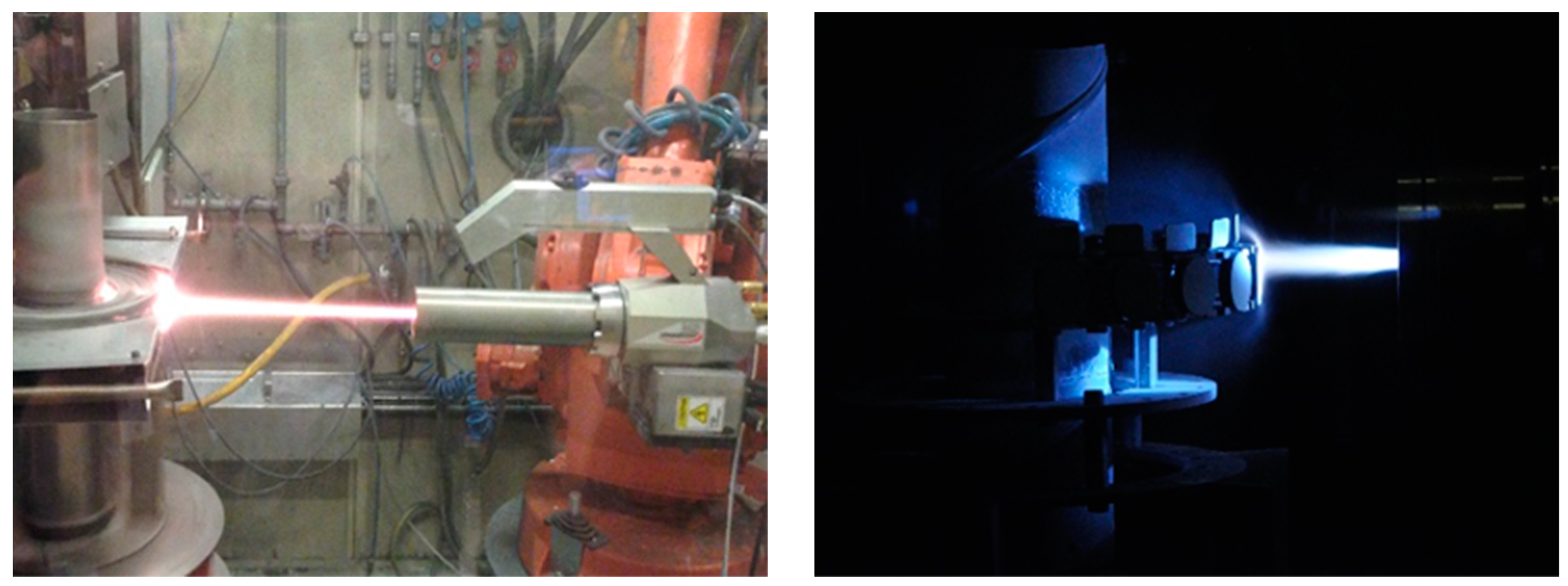
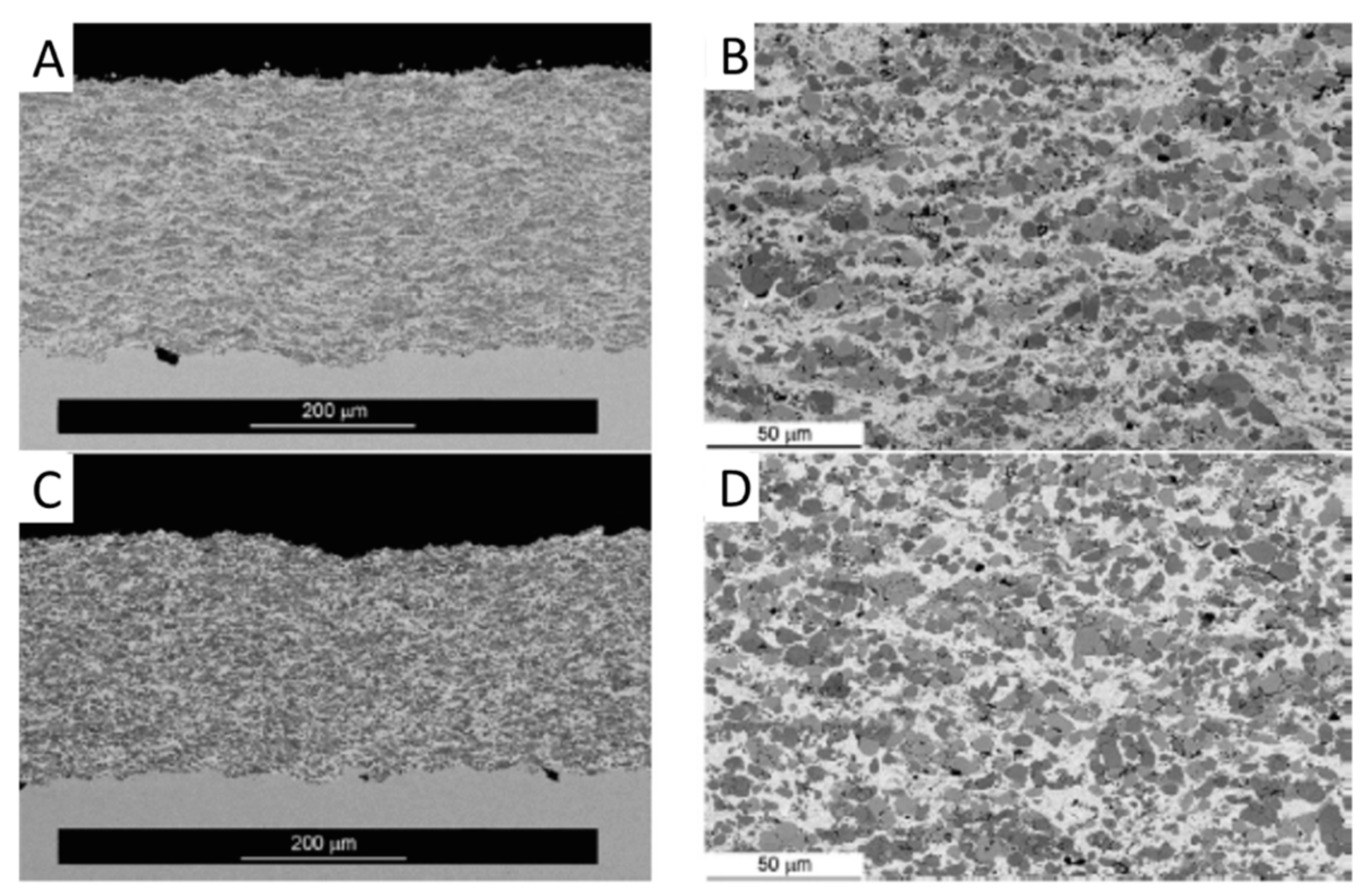
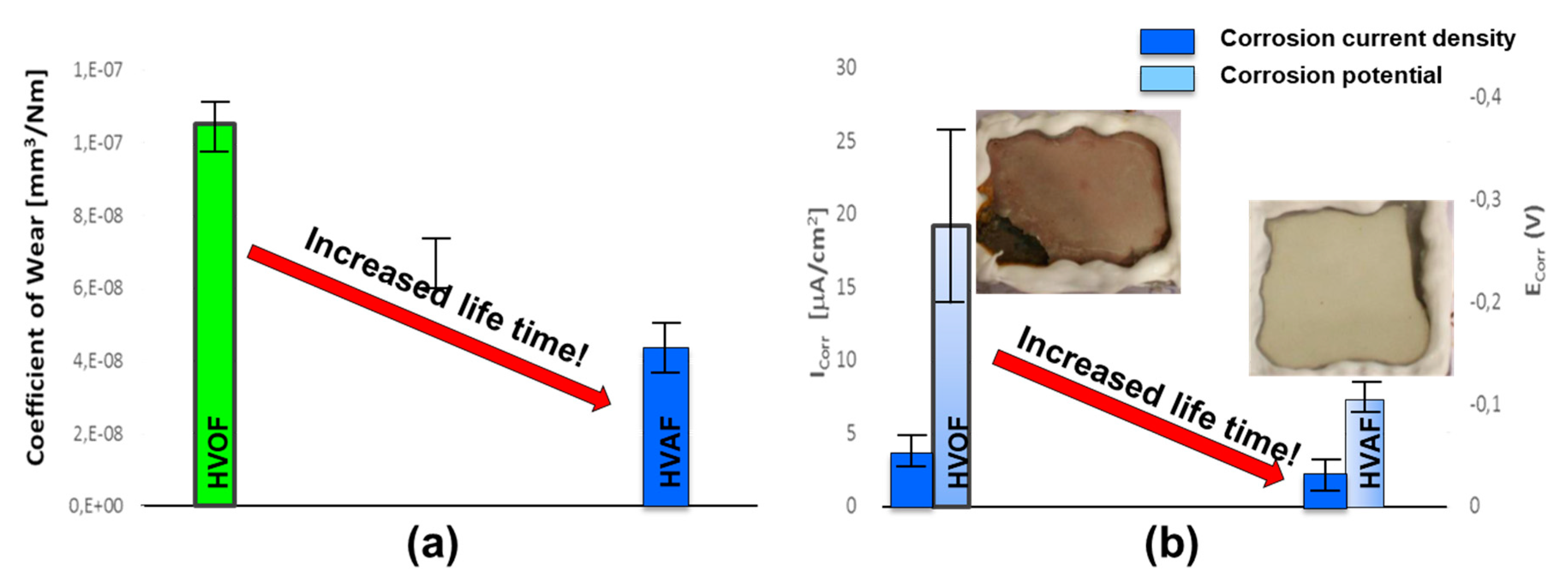
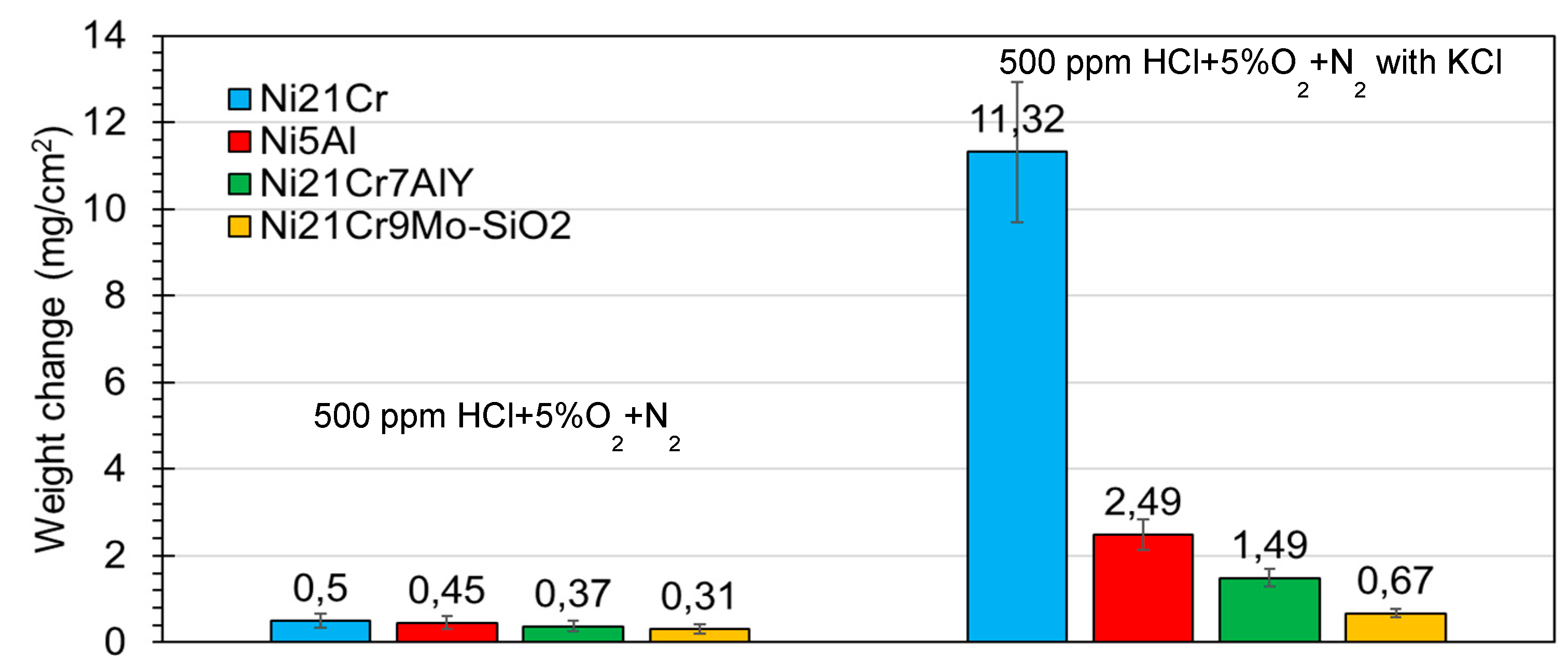
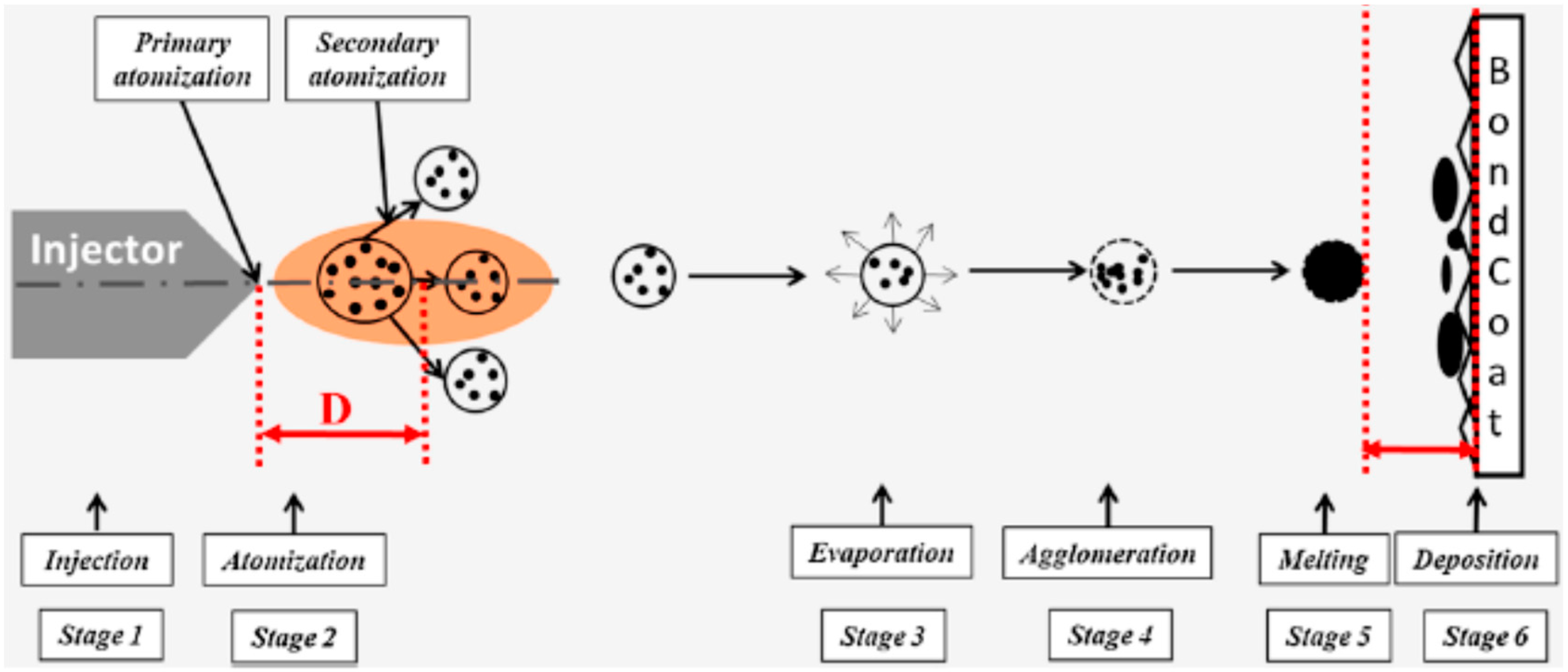
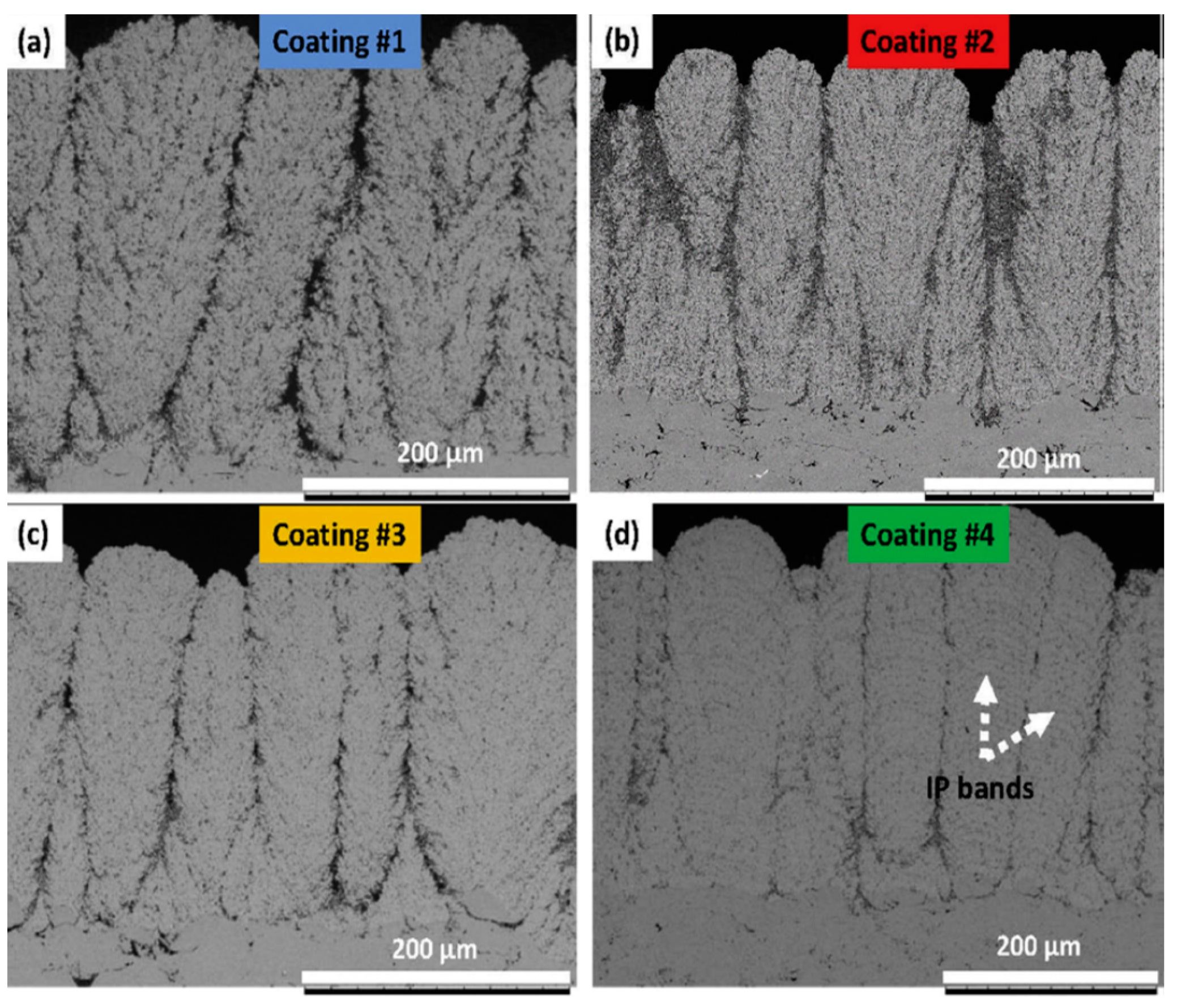

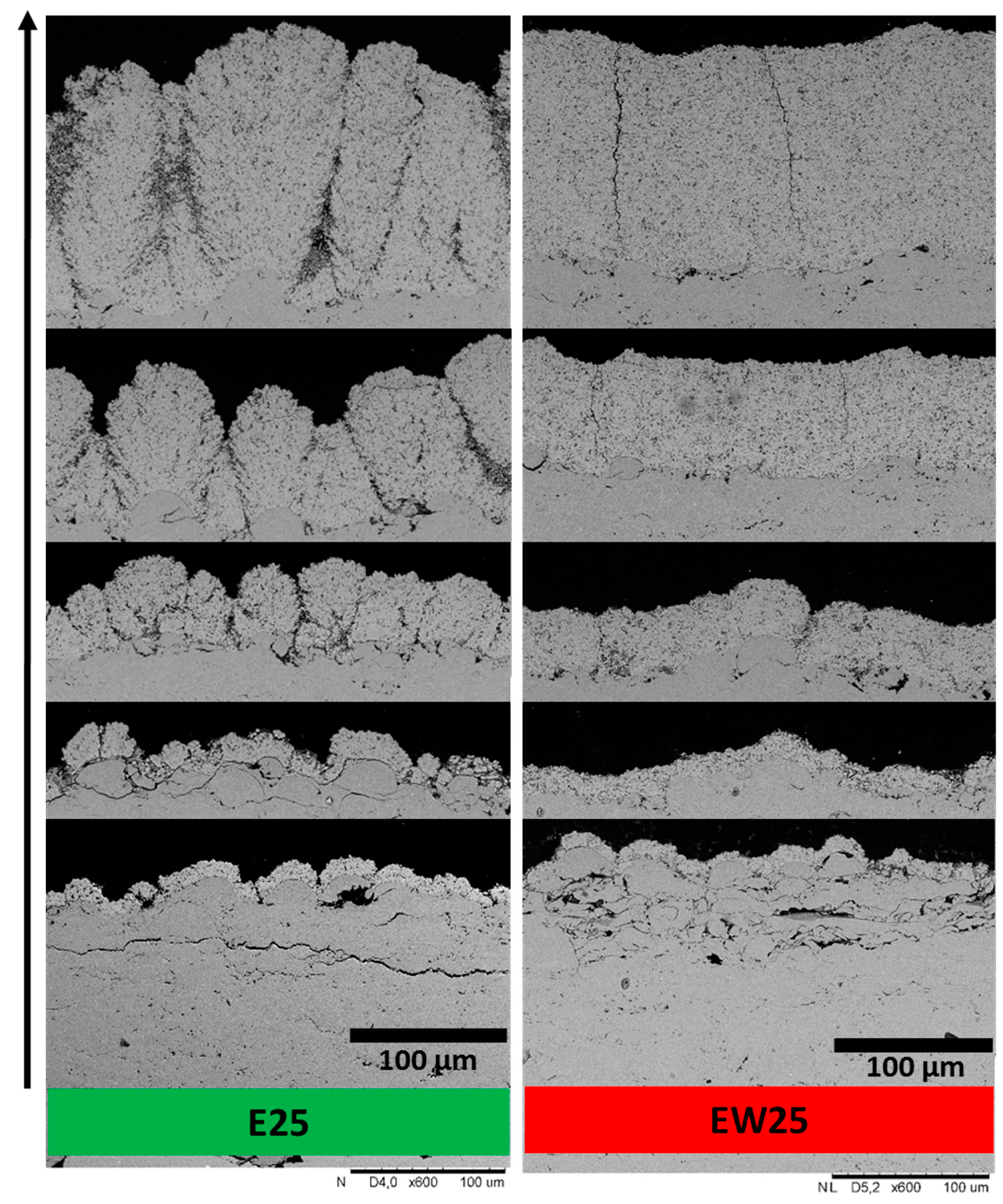
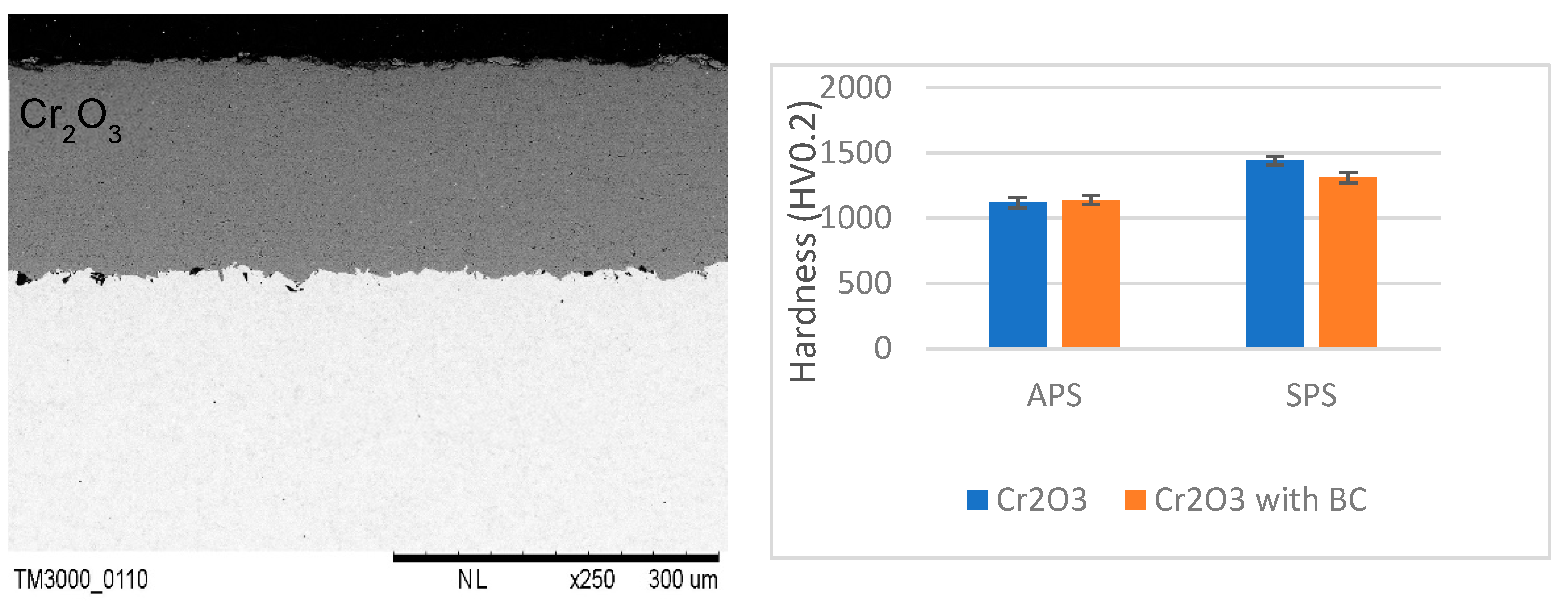
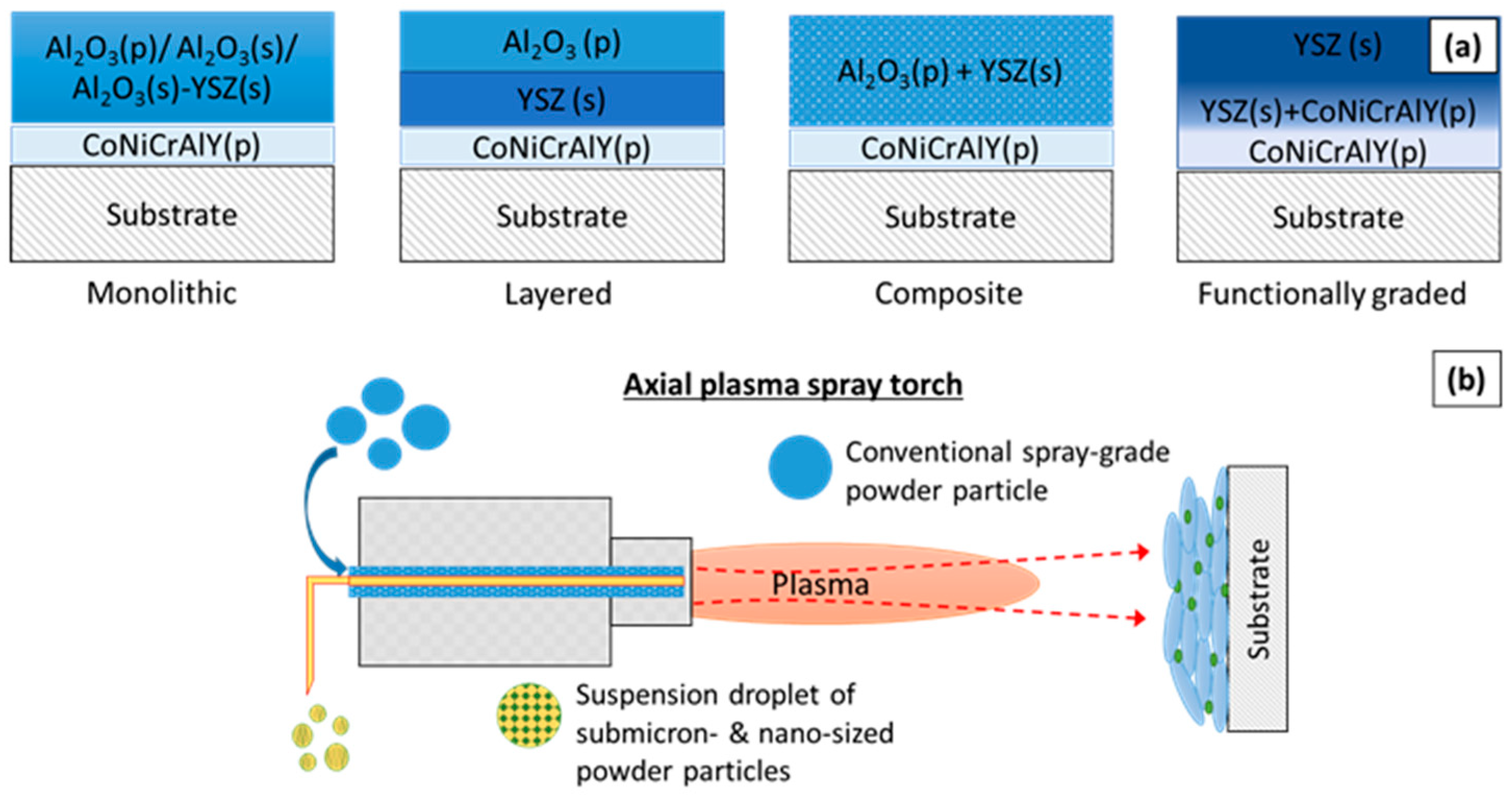
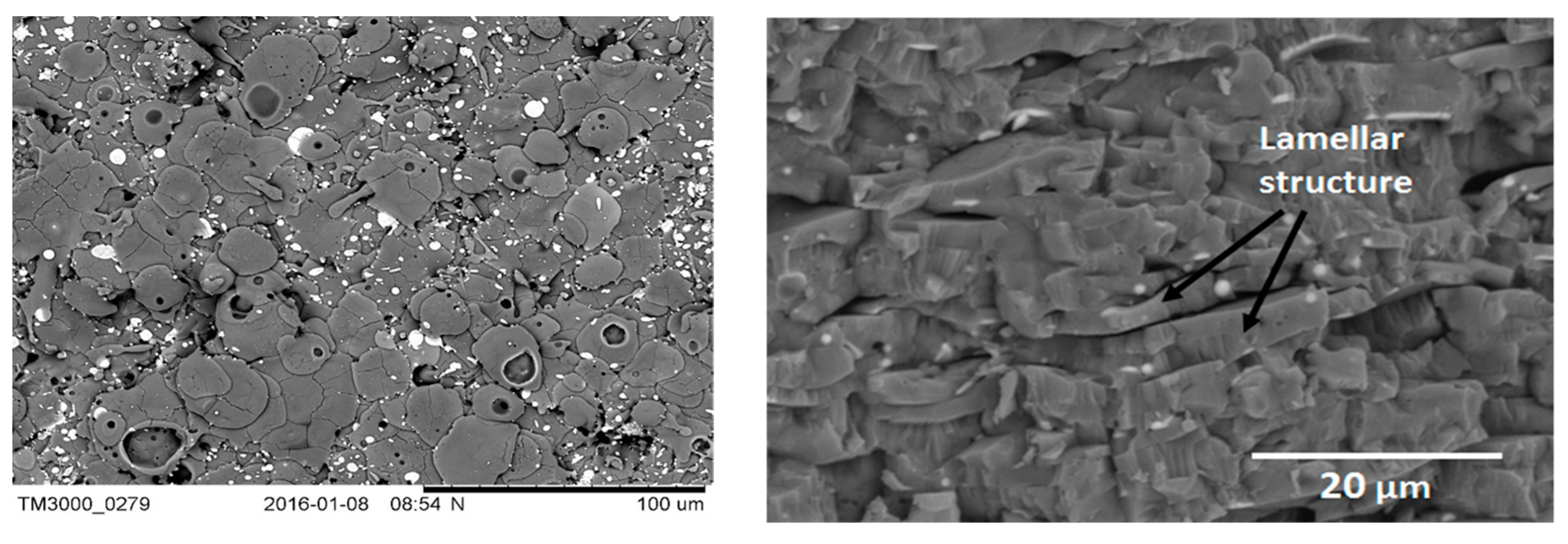
© 2019 by the authors. Licensee MDPI, Basel, Switzerland. This article is an open access article distributed under the terms and conditions of the Creative Commons Attribution (CC BY) license (http://creativecommons.org/licenses/by/4.0/).
Share and Cite
Joshi, S.; Nylen, P. Advanced Coatings by Thermal Spray Processes. Technologies 2019, 7, 79. https://doi.org/10.3390/technologies7040079
Joshi S, Nylen P. Advanced Coatings by Thermal Spray Processes. Technologies. 2019; 7(4):79. https://doi.org/10.3390/technologies7040079
Chicago/Turabian StyleJoshi, Shrikant, and Per Nylen. 2019. "Advanced Coatings by Thermal Spray Processes" Technologies 7, no. 4: 79. https://doi.org/10.3390/technologies7040079
APA StyleJoshi, S., & Nylen, P. (2019). Advanced Coatings by Thermal Spray Processes. Technologies, 7(4), 79. https://doi.org/10.3390/technologies7040079





